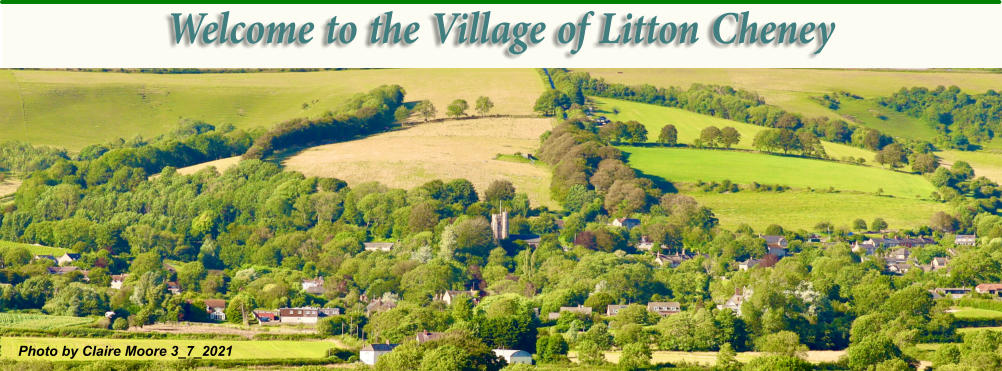Litton Cheney Friendly Society and Ancient Order of Foresters
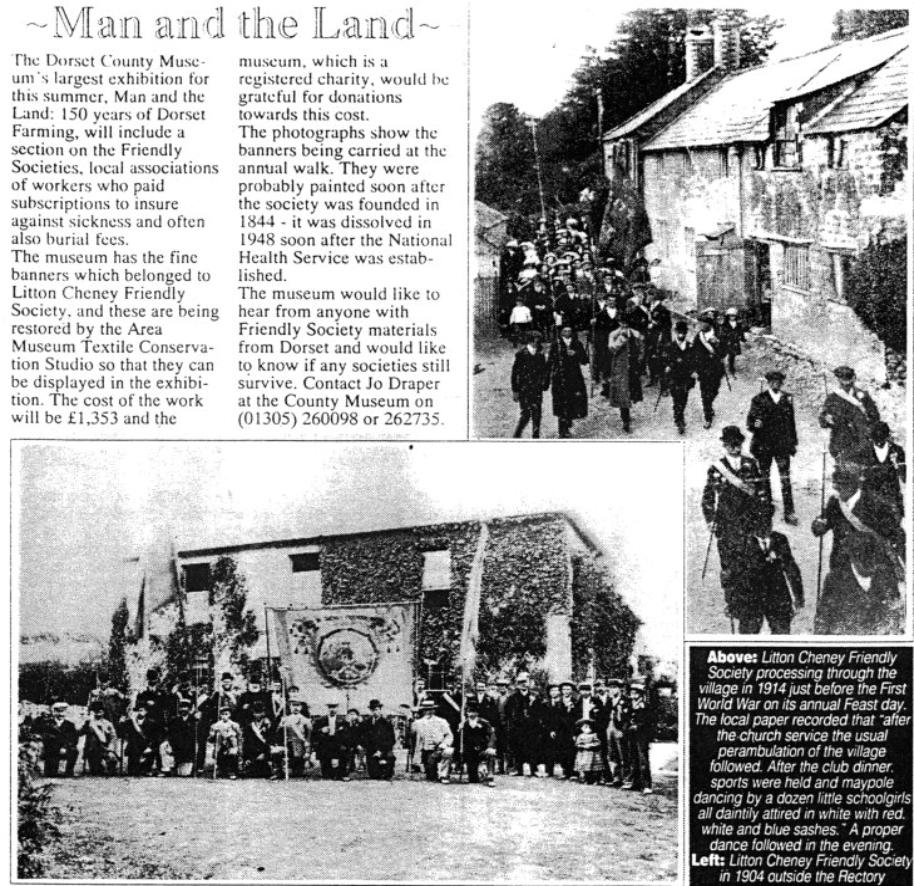
From the London Gazette, 16 December, 1949
Friendly Societies Act,1896
Advertisement of Dissolution by Instrument.
NOTICE is hereby given that the LITTON CHENEY FRIENDLY SOCIETY Register No.121 Dorset held at The Rectory
Schoolroom, Litton Cheney, Dorchester in the county of Dorset, is dissolved by Instrument, registered at this Office the 12
th
Day of December,1949, unless within three months from the date of the Gazette in which this advertisement appears
proceedings be commenced by a Member or other person interested in or having any Claim on the funds of the society to set
aside such dissolution, and the same be set aside accordingly.
Dated the 12
th
day of December 1949 .
B.K.WHITE,Chief Registrar.
17, North Audley Street,
London, W1
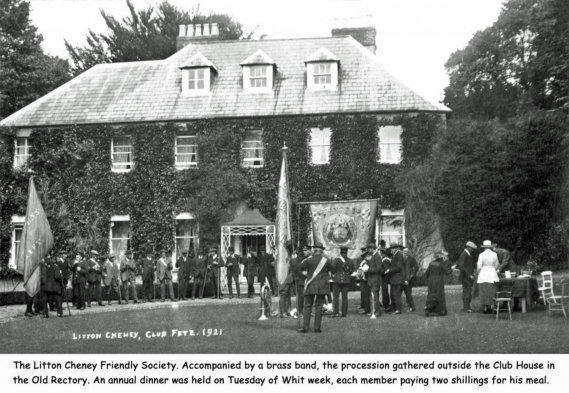

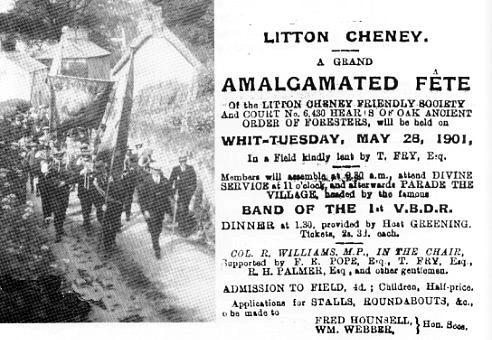
End of an Enterprise
The Passing Scene - Last Walk of a Dorset Club
Memories Recalled at Litton Cheney
Founded in 1844, the Litton Cheney Friendly Society, which annually held its annual club fete on
Whit-Tuesday, has ended its activities. With the State health scheme in action membership had
dropped to twenty and it was generally felt that the time had arrived for the Club's legal
dissolution. Inspired by Lieut.-Col. C. R. Wordsworth, of Baglake, members and old established
families, in whom traditions were firmly rooted, decided that, before dissolution, the Club should
walk again with banners flying and band playing as in the good old days. Thus it came about that
on Saturday afternoon the Litton Cheney Friendly Society held its Club Walk for the last time and
villagers and visitors looked with deep regret upon a procession which it is extremely unlikely will
ever again be seen in the streets of this lovely unspoilt village. Old established families decorated
their houses with flags, the large standard floated from the church tower and merry touches were
rung upon the ring of six in St. Mary's tower. Mr. C. Fry was responsible for displaying the cerise
and blue silk banner of the Society by the church font and putting the blue and gold standards
one each side of the archway leading to the chancel.
END OF AN ENTERPRISE
The afternoon service at St. Mary's Church was conducted by the Rector (Rev. Canon E. S.
Daniell), and the Lesson was read by Rev. C. W. Wright, rector of Longbredy. Miss Olive Gladwyn
(hon. secretary of the Friendly Society). was the organist. The sermon was preached by Rev. R. D.
St. G. Edwards, sometime rector of Longbredy and treasurer of the Society for the last 32 years,
who had come from Berkshire to be present. Their Society, he said, was years ahead of its time in
its ideals, many of which were now incorporated into the State scheme, which rendered the village
organisation unnecessaryand, therefore, it had now reached the end of its usefulness. After the
service the splendid banner and the two blue and gold silk standards, dated 1844, were borne from
the church, past the grave of the Rev. J. Cox, a founder and a procession was formed. Leading
the procession, as of old, was Mr. Arthur Gladwyn, for 17 years hon. secretary of the Friendly
Society, who had specially come from Wimborne for the final ceremony. He was wearing his blue
official sash. His grandfather, the late Mr. James Gladwyn, was a founder member. The leading
standard was borne aloft by Mr. Fred Dennett. The banner was carried by Mr. M. Thorner and Mr.
W. Pile and the second standard by Mr. F. Burt. The Winterborne Whitchurch Brass Band was in
attendance and a number of Club members and young and old inhabitants and old Littonians made
up the procession. Among the members wearing regalia and carrying their Club Poles were
Messrs. William Travers. William Pile, M. Thorner, G. Thorner, F. Burt and C Greening. Messrs. C.
Fry and A. Trevett carried their late fathers' Club Poles.
JOURNEY'S END
"Zoo off they started, two an' two,
Wi' painted poles and knob o' blue,
an' girt silk flags”.
With the band playing stirring tunes, the procession marched, as of old, along the church
path, up Redway, by the old Cross Tree, on through Puddlehole to Baglake, the home of
Lieut.-Col. C R. Wordsworth and where once lived that fine yeoman farmer, the late Mr.
Thomas Fry, a staunch supporter of the Club in his time. Retracing their steps, the Club
Walk continued down the main street. The thoughts of many, as they Passed the Green,
were of the triumphal arch which, for many Whit-Tuesdays, spanned the road, erected by the
late Mr. George Fry, the last man to be seen wearing a smock frock in the village. Down to
the White Horse Inn and to the White Cross Bakery, where once upon a time the late Mr.
Samuel Moores, originator of the knob biscuits famous the world over, made them by hand,
42 to the pound. Turning about, the last Club Walk, with band playing and colours flying,
went up the street with its silver streams on either side, back to the church steps, journey's
beginning and journey’s end alike for generations of folk and for the Friendly Society's Club
Walk too. The banner and standards were reverently placed, prior to laying up, on the
Rectory lawn. A welcome tea was enjoyed in the Rectory Sunday Schoolroom, provided by
Mrs. Fry, Mrs. A. Trevett, Mrs Honeybun, Mrs Hiscock. Mrs. Han and Miss Olive Gladwyn
(Friendly Society hon. secretary).
A general meeting followed attended by the trustees (Lieut. -Col. C. R- Wordsworth, Canon E. S. Daniell, (Canon Trotman was unavoidably
absent) and members. Rev. R. D. Edwards (treasurer) was unanimously voted to the chair. The necessary steps were taken to procure the
legal dissolution of the Society. It was unanimously decided that the Club regalia be kept in the village. Various suggestions were put forward
for its safe keeping and a final decision will be made when the Club closes down and shares out its funds in October. All then went to the Court
House where, by kind permission of Mr. C. H. A. Newman, the band played selections on the lawn, with dancing and time honoured skittling to
occupy the evening. So ended Litton Cheney Friendly Society's last Club Walk, which now passes into history, along with its 13th century wake,
with adjoining Puncknowle's September veast, Burton Bradstock’s veast and perhaps Litton Cheney's famous mumming play "Crimea."
Friendly societies were local associations of workers who paid subscriptions for the purposes of insurance, pensions, savings or co-
operative banking. Before modern insurance and the welfare state, friendly societies provided financial and social services to
individuals, often according to their religious, political, or trade affiliations. In 1846 the Litton Society paid five shillings per week for four
weeks then three shillings per week for the remainder of the illness. The average wage for labourers in Dorset at that time was seven
shillings per week.
The Litton Cheney Friendly Society was in existence from 1844 until 1948. The annual anniversary was celebrated every Whit-Tuesday
with a church service and, with banners flying and the band playing, a procession around the village stopping at various watering holes
for refreshments. A sumptuous dinner was provided for members of the Society followed by games and dancing into the evening.
A regular account of the proceedings was published in the local newspapers, some of which can be read here.
A Court of the Hearts of Oak Ancient Order of Foresters also existed in the Village for many years, providing much the same
charitable services as the Friendly Society. Unfortunately, it did not seem to attract the same level of reporting in the press as
the Friendly Society.so very few details are known. However, there are reports of amalgamated fetes being held in the
years1892 to1901.
HISTORIC ARCHIVE
ABOUT LITTON CHENEY

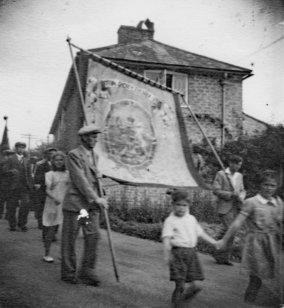
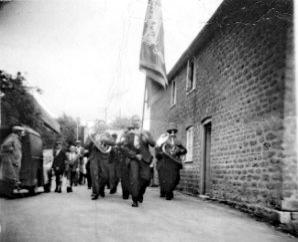
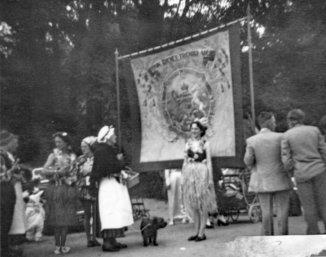
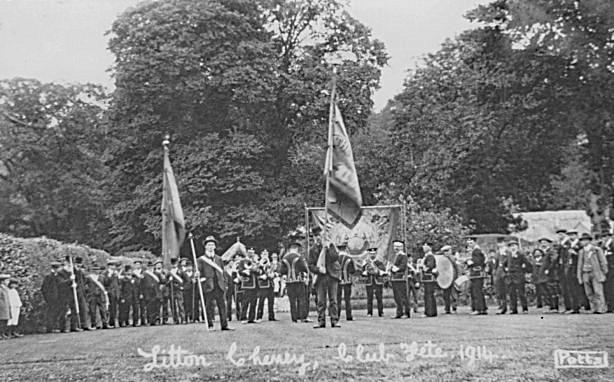
Rules of the Friendly Society
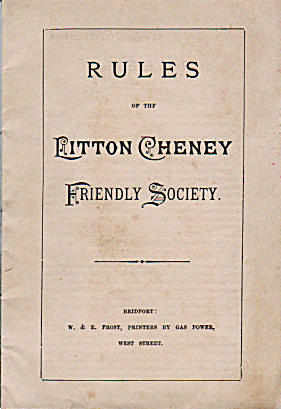
All previous Rules rescinded.
RULES.
I.— Constitution of Society.
The Society is a Friendly Society, composed of persons over sixteen years of age.
II.—Name of Society and Place of Registered Office.
The Society is called “THE LITTON CHENEY FRIENDLY SOCIETY." Its office is in England, and is at the Rectory Schoolroom, Litton Cheney, in the
County of Dorset. In the event of any change in the situation of the registered office, notice of such change shall be sent within fourteen days thereafter to the
Registrar in the form prescribed by the Treasury regulation in that, behalf. — Friendly Societies Act, 1875, s14 (la).
III.—Objects and Purposes, Admission of Members, Conditions of Benefit, &c.
(1). Objects for which the Society is established - This Society is established to provide, by voluntary subscriptions of the members, with the aid of donations,
for the relief or maintenance of the members during sickness or other infirmity except lunacy. For assistance by contributions towards the funeral expenses of
a member or of the deceased wife of a member; for providing medical attendance to members during sickness.
(2). Purposes f or which the fund shall be applicable. —All moneys received on account of contributions, donations, admissions, fines or otherwise, shall be
applied towards carrying out the objects of the society, according to the rules and tables (if any) thereof. Any officer misapplying the funds shall repay the
same and be excluded, without prejudice to his liability to prosecution for such misapplication.
3
(3.) Terms of admission of Members. — Candidates for membership must be resident, in the parish of Litton Cheney, or in the villages lying within four miles
of the Litton Cheney Church, over sixteen years of age and under forty-six. Candidates must, give in their names to the Secretary; they must be elected by a
general ballot of the Society, and for election must obtain the votes of three fourths of the members present; they must produce a satisfactory medical
certificate of present health, and pay an entrance fee of two shillings and sixpence.
(4). Conditions under which members become entitled to benefits —
(a.) Sick benefit of 10s. a week for first month of illness; 6s. a week for the next two months; 3s. a week for rest of illness up to end of term. Any arrears due
must be deducted from first payment. For this benefit each member must pay a weekly contribution of sixpence, payable at the quarterly meetings. This
benefit cannot be received by any member after his sixty-fourth year — nor can it be received on account of any sickness or accident resulting from venereal
disease, rioting, profligacy or drunkenness, nor is it applicable in cases of lunacy. Any member convicted of feigning himself sick, or otherwise attempting to
defraud the Society, shall be for ever excluded from it. Any member claiming this benefit must send written notice to the stewards or secretary, together with
a medical certificate.
(b). Medical attendance during sickness. — The club doctor will attend sick members at the uniform charge of 1s. per visit. For this benefit each member
pays 1s. at each quarterly meeting.
(c.) Funeral Benefit. — A contribution of 1s. is given by each member towards the funeral expenses of a deceased member. A similar contribution of sixpence
per member is given towards the funeral expenses of a member's deceased wife.
(5). Fines and Forfeitures to be imposed on Members. — For refusing to undertake the office of committeeman, a fine of one shilling. For neglecting to
attend a meeting of the committee, except on account of illness, sixpence. For omitting to pay the quarterly contributions, threepence for each omission. For
using profane language in club-room, or coming into club-room intoxicated, or for causing any quarrel or disturbance, a fine of sixpence.
4
(6). Provisions for Expenses of Management — The necessary expenses of the management of the society shall be provided for by the payment by each
member of sixpence a year, to be paid at the general meeting on Whitsun Tuesday.
(7). There shall be a dinner provided on Tuesday in Whitsun week, at such place as shall be suitable for the purpose, when each member present shall pay two
shillings for his dinner. The members are expected to walk in procession, two and two, each to Litton Cheney Church, where a Sermon will be preached by
the- minister of the parish or some other Clergyman. In the afternoon the secretary or stewards shall call the members together to walk in procession, each
member to walk in the place assigned him as he is called over. All other particulars relating to the management of the said feast shall be regulated by the
committee and stewards who shall meet for that purpose, ten days previous to the feast day each year. No part of the expenses of the feast shall come out of
any of the funds. Attendance shall be voluntary.
IV.—Meetings: Right of Voting.
Meetings of the Society shall be held quarterly on the first Monday in the months of January, April, July and October at 7 p.m. in the club-room. A meeting
can be summoned by the Secretary, or by the joint action of any six members. Ten members shall form a quorum in a general meeting and five shall form a
quorum in a committee meeting. The president, Treasurer or Senior Committeeman is Chairman. Every member has a right to vote; the Chairman, in case of
equality, has a casting vote.
V.—New Rules and Alteration of Rules.
No new rule shall be made nor any of the rules herein contained or hereafter to be made shall be amended, or rescinded, unless by the consent of a majority
of the members present at a general meeting of the Society specially called for that purpose. No amendment of rules is valid until registered.
5
VI.—Appointment, and Removal of Committee of Management, Treasurer, Trustees and other Officers.
There shall be a committee of management consisting of nine persons, a treasurer, secretary and two auditors. The committee of management, treasurer and
secretary shall continue in office until the general annual meeting of the Society, unless previously removed by a resolution of the major part of the members
present at any meeting called for that purpose, and at every annual meeting a committee of management, treasurer and secretary shall be appointed for the
ensuing year or, in failure thereof, those last appointed shall be considered as again appointed; and in case any member of the committee of management,
treasurer or secretary die, resign or be removed prior to such annual meeting, the committee of management shall appoint a person to fill the vacancy.
There shall be three trustees. The trustees shall continue in office during the pleasure of the society and be re movable at a general meeting; and, in case of a
vacancy, another shall be elected by a majority of members at a meeting called for that purpose. A copy of every resolution appointing a trustee shall be sent
to the registrar within fourteen days after the date of the meeting at which such resolution was passed, in the form prescribed by the Treasury Regulation on
that behalf.
VII. — Powers and Duties of Officers.
1. The committee of management shall meet half an hour before each quarterly meeting. Any 5 of the committee of management duly assembled at any such
meeting shall form a quorum and shall have full power to superintend and conduct the business of this society according to the rules provided for the
governance thereof and shall in all things act for and in the name of this society and all acts and orders under the powers delegated to them shall have the like
force and effect as the acts and orders of this society at any general meeting. Every question at such meeting shall be decided by a majority of votes and, if
the votes are equal, the chairman shall have a casting vote.
6
Any two of the committee of management may call a special meeting thereof, by giving seven clear days' notice in writing to the secretary, but at such special
meeting no other business than that specified in the notice shall be taken into consideration. The committee of management shall convene all the meetings of
the society on such requisitions as are herein mentioned.
2. The treasurer shall, in the month of June in every year, and also when required by a general meeting, or by the trustees or committee of management upon
demand made, or notice in writing given to him or left at his last or usual place of residence, render a just and true account of all moneys received and paid
by him on account of the society; and shall also, on the like demand or notice, pay over all moneys and deliver all property for the time being in his hands or
custody to such persons as a general meeting, or the committee of management or the trustees appoint. He shall be responsible for such sums of money as
may from time to time be paid into his hands by the secretary, or by any person on account. of this society, (he shall balance his cash account monthly, and
supply the secretary with a duplicate thereof), and shall, if required, attend every general meeting. He shall, before taking upon himself the execution of his
office, give security, pursuant to the Friendly Societies Act, 1875, s.20 (l).
3. The secretary shall give his attendance at all meetings of this society; he shall record correctly the names of the members of the committee of management
or trustees there present, and the minutes of their proceedings, which he shall transcribe into a book to be authenticated by the signature of the chairman as
the proceedings of the meeting; he shall receive proposals for admission, and demands for allowances of every description granted by the rules; he shall keep
the accounts, documents and papers of the society in such manner for such purpose as the committee may appoint, and shall prepare and send all returns and
other documents required by the Friendly Societies Acts, or the Treasury Regulations to be sent to the Registrar. The Secretary shall, on all occasions, in the
execution of his office, act under the superintendence, control and directions of the committee of management.
7
4. The trustees shall be admitted to all meetings of the committee of management and shall be at liberty to take part in the proceedings thereof and vote on
any question under discussion.
5. In case any trustee being removed shall refuse or neglect to assign or transfer any property of the society as the committee of management shall direct, he
shall (if he be a member) be expelled the society and shall cease to have any claim on the society on account of any contributions paid by him, without
prejudice to any liability to prosecution which he may have incurred.
VIII.
At the end of every five years after all existing claims on the Society have been met the general funds of the society shall be divided among the members in
proportion to the amount, of contributions paid by each — the Reserve Fund (now £100) must be first made up and set aside and cannot be divided.
IX.—Copies of Rules.
It shall be the duty of the committee of management to provide the secretary with a sufficient number of copies of the rules to enable him to deliver to any
person on demand a copy of such rules on payment of a sum not exceeding 1s. for non-members and 6d. for members and of the secretary to deliver such
copies accordingly — Friendly Societies Act, 1875, s.13(5)
Each member must buy a copy of rules.
X.—Keeping and Auditing of Accounts.
(l.) The committee of management shall cause the accounts of the society to be regularly entered in proper books.
(2.) Separate accounts shall be kept of all moneys received or paid on account, of every particular fund or benefit assured by the society, for which a separate
table of contributions payable is adopted, distinct, from all moneys received and paid on account, of any other benefit or fund.
(3.) A separate account shall also be kept of the expenses of management of the society and of all contributions on account thereof.
8
(4.) The committee of management shall once at least in every year submit the accounts, together with general statement of the same and all necessary
vouchers up to the 31st December then last, for audit, either to one of the public auditors appointed under the Friendly Societies Act, 1875, or to two or more
persons appointed as auditors by the members at the meeting next before each yearly meeting of the society and shall lay before every such meeting a
balance sheet, (which may or may not be identical with the annual return, but must not be in contradiction to the same), showing the receipts and
expenditure, funds and effects of the society, together with a statement of the affairs of the society since the last ordinary meeting and of their then condition.
Such auditors shall have access to all the books and accounts of the society, and shall examine every balance sheet and annual return of the receipts and
expenditure; funds and effects of the society, and shall verify the same with the accounts and vouchers relating thereto and shall either sign the same as found
by them to be correct, duly vouched, and in accordance with law, or shall specially report to the meeting of the society before which the same is laid in what
respects they find it incorrect, unvouched, or not in accordance with Societies Act, 1875, s.14 (1c.)
XI.—Annual Returns.
1. Every year before the 1st of June the committee of management shall cause the secretary to send to the Registrar, as required by the Friendly Societies Act,
1875, the annual return in the form prescribed by the Chief Registrar of Friendly Societies, of the receipts expenditure funds and effects of the society and of
the number of members of the same, up to the 31st December then last inclusively, as audited and laid before a general meeting, showing separately the
expenditure in respect of the several objects of the society together with a copy of the auditors’ report, if any.
2. Such return shall state whether the audit has been conducted by a public auditor appointed under the Friendly Societies Act, 1875, and by whom and, if
such audit has been conducted by any persons other than a public auditor, shall state the name, address and calling or profession of each of such persons and
the manner in which, and the authority under which; they were respectively appointed. — Friendly Societies Act, 1875, s.14 (1d.)
3. It shall be the duty of the committee of management to provide the secretary with a. sufficient number of copies of the annual return, or of some balance
sheet or other document, duly audited, containing the particulars as in the annual return as to the receipts and expenditure, funds and effects of the society,
for supplying gratuitously every member or person interested in the funds of the society, on his application, with a copy of the last annual return of the
society, or of such balance sheet, or other document; for the time being and it shall be the duty of the secretary to supply such gratuitous copies on application
accordingly. — Friendly Societies Act 1875, s.14 (1h).
XIL—Valuations.
l. Once at least in every five -years the assets and liabilities of the society (including the estimated risks and contributions) shall be valued in a manner
provided the Friendly Societies Act 1875, s14 (1f).
2. It shall be the duty of any valuer appointed by the society to make a report, to be signed by him and which shall also state his address and calling or
profession, on the condition of society and also an abstract of the results of his valuation, in the form prescribed by the Chief Registrar.
3. On receiving such report it shall be the duty of the committee of management to call forthwith a special meeting of the society for the purpose of receiving
the same and to lay such report and the abstract of the results of valuation before such meeting and to cause the secretary to forward such report to the
Registrar, together with a return containing such information with respect to the benefits assured and contributions receivable by the society and to its funds
and effects, debts and credits as from time to time the Registrar may require.
10
XIII.—Inspection of Books.
1. The books and accounts of the society shall be open to the inspection of any member or person having an interest in the funds of the society at all
reasonable hours, at the registered office of the society or at any place where the same are kept, except that no such member or person, unless he be an officer
of the society or be specially authorised by a resolution of the society to do so, shall have the right to inspect the loan or deposit account of any other member
without the written consent of such member, and it shall be the duty of the secretary to produce the same.—Friendly Societies Act, 1875, s.14 (lg.)
2. It shall be the duty of the committee of management to keep a copy of the last annual balance sheet of the society for the time being, together with the
report of the auditors, if any, and of the last quinquennial valuation for the time being, always hung up in a conspicuous place at the registered office of the
society — Friendly Societies Act, 1875, s.14 (1i.)
XIV.—1nvestment of Funds, Holding of Land, &c.
So much of the funds of the society as may not be wanted for immediate use, or to meet the usual accruing liabilities, shall, with the consent of the committee
of management, or of a majority of members of the society present and entitled to vote at a general meeting, be invested by the trustees in such of the
following ways as such committee or general meeting shall direct; namely in any savings bank certified under the Act of 1863, or Post Office Savings Bank,
in the public funds, or with the Commissioners for the Reduction Of the National Debt, or upon Government or real securities in Great Britain or Ireland, or
in the purchase of land, or in the erection or alteration of offices or other buildings thereon as after-mentioned.— Friendly Societies Act, 1875, s.16 (l)
11.
XV.—Voluntary Dissolution.
The society may at any time be dissolved by the consent of five-sixths in value of the members, including honorary members, if any, testified by their
signatures to some instrument of dissolution in the form provided by the Treasury Regulations in that behalf, and also by the written consent of every person
for the time being receiving or entitled to receive any relief or benefit from the funds of the society, unless the claim of such person be first duly satisfied, or
adequate provision made for satisfying such claim; the value of members to be ascertained by giving one vote to every member, and an additional vote for
every five years that he has been a. member, but to no one member more than five votes in the whole.—Friendly Societies Act, 1875, s.25 (1, 3, 7).
XVI.—Applications for Inspection, Special Meetings or Dissolution.
It shall be the right. of one-fifth of the total number of members, or if the number of members shall any time amount to 1,000 and shall not exceed 10,000 it
shall be the right of 100 members, or if the number shall at any time exceed 10,000 it shall be the right of 500 members, by an application in writing to the
Chief Registrar, signed by them in the forms respectively provided by the Treasury Regulations in that behalf:
(a.) To apply for the appointment of one or more inspectors to examine into the affairs of the society, and to report thereon. — Friendly Societies Act, 1875,
s.23 (1).
(b.) To apply for the calling of a special meeting of the Society — Friendly Societies Act, 1875, s.23 (2).
Either such application to be made upon such notice to the society and to be supported by such evidence for the purpose of showing that the applicants have
good reason for requiring such inspection to be made or meeting to be called, and that they are not actuated by malicious motives in their application, as the
Chief Registrar shall direct.
(c.) Or to apply for an investigation into the affairs of the society with a view to the dissolution thereof.
Such application as last aforesaid to set forth that the funds of the society are insufficient to meet the existing claims thereon, or that, the rates of contribution
fixed in the rules of the society are insufficient to cover the benefits assured, and the grounds upon which such insufficiency is alleged—Friendly Societies
Act, 1875, s.25 (8).
12
XV11. — Disputes.
1. If any dispute shall arise between a member, or person claiming through a member, or under the rules of the society and the society or officer thereof, it
shall be referred to arbitration.
2. Five arbitrators shall be elected, none of them being directly or indirectly interested in the funds of the society; and in each case of dispute the names of the
arbitrators shall be written on pieces of paper, and placed in a box or glass, and the three whose names are first drawn out by the complaining party, or by
someone appointed by him or her, shall be the arbitrators to decide on the matter in difference. In case of a vacancy or vacancies, another arbitrator, or other
arbitrators, shall be elected at a general meeting.
XVIII.-Funera1 Benefit.
No money shall be paid upon the death, otherwise than at sea or abroad, of a member or other person whose death is or ought to be entered in any register of
deaths, except upon the production of certificate of such death under the hand of the registrar of deaths, or other person having the care of the register of
deaths in which such death is or ought to be entered (Friendly Societies Act, 1875, s.14 (2)




